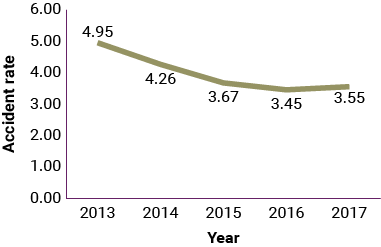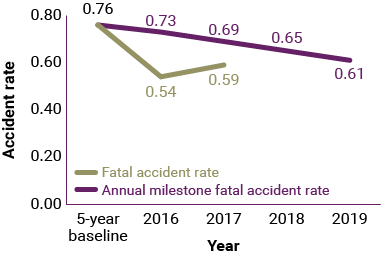
The total number of helicopter accidents increased in the United States in 2017, compared with totals from the previous year, but preliminary data for most of the world showed “an encouraging trend of safer civil helicopter operations,” according to the International Helicopter Safety Team (IHST) and its U.S. affiliate.
| Region | Accidents | Fatal Accidents |
|---|---|---|
Notes
Source: International Helicopter Safety Team |
||
| North America — United States | ||
| 2013 | 146 | 30 |
| 2014 | 138 | 21 |
| 2015 | 121 | 17 |
| 2016 | 106 | 17 |
| 2017 | 121 | 20 |
| North America — Canada | ||
| 2013 | 27 | 6 |
| 2014 | 27 | 6 |
| 2015 | 33 | 5 |
| 2016 | 28 | 2 |
| 20171 | 26 | 1 |
| North America — Mexico | ||
| 2013 | 8 | 3 |
| 2014 | 7 | 1 |
| 2015 | 8 | 3 |
| 2016 | 7 | 2 |
| 2017 | 12 | 3 |
| Europe2 | ||
| 2013 | 103 | 25 |
| 2014 | 98 | 15 |
| 2015 | 84 | 17 |
| 2016 | 52 | 12 |
| 2017 | 43 | 11 |
| CIS/Russia3 | ||
| 2013 | 19 | 7 |
| 2014 | 23 | 12 |
| 2015 | 22 | 10 |
| 2016 | 30 | 12 |
| 2017 | 11 | 4 |
| India | ||
| 2013 | 5 | NA |
| 2014 | 0 | 0 |
| 2015 | 4 | 3 |
| 2016 | 1 | 1 |
| 2017 | 2 | 1 |
| Brazil | ||
| 2013 | 25 | 4 |
| 2014 | 20 | 6 |
| 2015 | 17 | 6 |
| 2016 | 19 | 5 |
| 2017 | 10 | 2 |
| New Zealand | ||
| 2013 | 21 | 3 |
| 2014 | 14 | 5 |
| 2015 | 17 | 3 |
| 2016 | 12 | 2 |
| 2017 | 14 | 2 |
| Totals | ||
| 2013 | 354 | 78 |
| 2014 | 334 | 60 |
| 2015 | 306 | 64 |
| 2016 | 255 | 53 |
| 2017 | 239 | 44 |
In a report issued in early March, the IHST — which represents a joint safety effort begun in 2005 by government and industry — said that preliminary 2017 data from 49 countries show that most of the countries recorded fewer total accidents and fewer fatal accidents in 2017 than in 2016 (Table 1).
“Using combined data from these 49 countries, total civil helicopter accidents in 2017 were down 6 percent compared to the prior year, and fatal accidents were reduced by 17 percent, year over year,” the IHST report said. “Comparing 2017 to 2013, total accidents decreased by 32 percent and fatal accidents were cut by 44 percent.”
The IHST said that a continuation of the positive trend would enable IHST members to “push on with expanding a culture of safety and increasing cooperation on safety issues … within the global helicopter community.”
The IHST said that this year, it would work with its regional teams around the world to focus on three goals:
- Reducing risk and improving safety “through widespread and persistent distribution of relevant educational materials”;
- Analyzing accident causes and developing data-driven safety actions; and,
- Moving the industry to “adopt safety practices or equipment that will reduce the number of accidents.”
In a separate report, the U.S. Helicopter Safety Team (USHST) said preliminary data showed that the accident rate “flattened out” in 2017 at 3.55 accidents per 100,000 flight hours, slightly higher than the 3.45 accidents per 100,000 flight hours in 2016. Nevertheless 2017’s rate was about one-third below the 4.95 accidents per 100,000 flight hours recorded in 2013, the year the USHST was established (Figure 1).
The USHST said the 2017 total of 121 accidents was a result of “a few months … with uncharacteristically high accident totals,” including 18 accidents reported in February and 23 in July.
USHST data also reflected an increase in fatal helicopter accidents in the United States in 2017, with 20 fatal accidents and 34 associated fatalities. In comparison, of the 108 helicopter accidents recorded in 2016, 17 were fatal accidents, with 29 associated fatalities.
The U.S. fatal helicopter accident rate was 0.59 per 100,000 flight hours in 2017, an increase from 0.54 fatal accidents per 100,000 flight hours the previous year (Figure 2). The 2017 rate was, nevertheless, below the annual goal of 0.69 fatal accidents per 100,000 flight hours established by the USHST. Stated goals are for fatal accident rates of 0.65 per 100,000 flight hours this year and 0.61 per 100,000 in 2019.
IHST data for the United States and 48 other countries indicate that 239 helicopter accidents were reported in 2017, including 44 fatal accidents. In 2016, 255 accidents were reported in those countries, including 53 fatal accidents.
Other regions on the list include Canada, where 26 accidents, including one fatal accident, were reported in 2017; 32 countries in Europe,1 where 43 accidents, including 11 fatal accidents, were recorded; and the Commonwealth of Independent States (CIS),2 which recorded 11 accidents, including four fatal accidents.
In addition, 2017 data showed that Mexico recorded 12 accidents, including three fatal accidents; India recorded two accidents, one of them fatal; Brazil recorded 10 accidents, including two fatal accidents; and New Zealand recorded 14 accidents, including two fatal accidents.
Notes
- The reporting countries in Europe are Austria, Belgium, Bulgaria, Croatia, Cyprus, Czech Republic, Denmark, Estonia, Finland, France, Germany, Greece, Hungary, Iceland, Ireland, Italy, Latvia, Liechtenstein, Lithuania, Luxembourg, Malta, Netherlands, Norway, Poland, Portugal, Romania, Slovakia, Slovenia, Spain, Sweden, Switzerland, and United Kingdom.
- The reporting countries in the CIS are Armenia, Azerbaijan, Belarus, Kazakhstan, Kyrgyzstan, Moldova, Russia, Tajikistan, Turkmenistan, Ukraine, and Uzbekistan.




